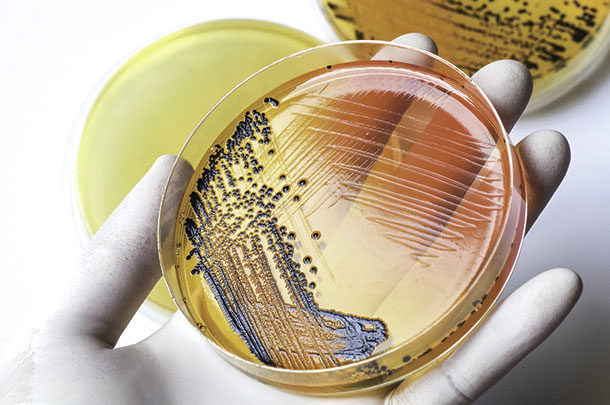Salmonella enterica (commonly referred to as salmonella) is a leading cause of foodborne illness. The Centers for Disease Control and Prevention estimates that salmonella causes over one million foodborne illnesses every year in the U.S.
The USDA Food Safety and Inspection Service (FSIS) found that contamination of ground beef with salmonella averages around 2.1%, and little to no improvement has been achieved over the past few decades. Research has shown that the major hurdle we face with salmonella is the pathogen’s ability to remain viable within the peripheral lymph nodes (LN) of cattle. As peripheral LN are not typically removed prior to grinding of beef, they are the most common source of contamination in ground beef products.
All things considered, the best strategy for reducing risk during processing is to find solutions that reduce the likelihood of salmonella getting into the lymphatic system from the gut and to reduce the amount of salmonella being shed in feces of animals, which can contaminate their hides. These solutions are considered by the USDA to fall in the area of pre-harvest food safety.
Salmonella’s path to lymph nodes
Salmonella can move from the mouth and into the gastrointestinal tract (GIT) relatively unperturbed by the host. Research conducted with mice showed that the bacterial population could double within the intestine every 5.9 hours and migrate to cecal LN at a rate of 298 cells per day. Breaking out of the GIT is a complex process that usually requires multiple failures of normal GIT physiology. In a healthy, unstressed animal, normal barrier protections cannot be overcome by one dose of one pathogen.
But when an animal and its GIT are experiencing multiple stressors – such as heat stress, dietary transitions or depressed intake coupled with a pathogen challenge – the barrier functions can faulter. This compounding of stressors and the subsequent pathological responses lead to what is called “leaky gut syndrome” (LGS).
Dr. Lance Baumgard, professor of animal science at Iowa State University, describes LGS as “the inability of the intestinal barrier to prevent unwanted molecules inside of the intestine from entering into the body.” In response to a detrimental shift in the microbiome in the GIT resulting from the aforementioned stressors, the host can mount an inflammatory response to protect the GIT from damage.
Pro-inflammatory signaling molecules can be released and macrophages and neutrophils can be recruited to challenged areas. These cell types produce reactive oxygen species (ROS) that can cause additional local stress and damage. The inflammation caused by these types of immune responses opens up intercellular channels through which salmonella can pass. Once salmonella exits the GIT and enters the portal blood system, it will be filtered into the lymphatic system and will end up in lymph nodes and the liver. In addition to breaking through the GIT during LGS, salmonella may also get a “free ride” to the lymph nodes via cells of the immune system.
The innate immune system, which is one of two main systems the body has to combat disease, is the most immediate response the immune system has once an antigen or foreign material is detected. The innate immune system could be thought of as our body’s first line of defense against pathogens. Dendritic cells have a unique role in this process as they sample the pathogen and bring it to T-helper cells, which are located within LN.
Once a T-helper cell determines how to best kill the pathogen, the adaptive immune response is activated. The adaptive immune response is associated with antigen-specific responses and is much more complex than innate responses. At this point, specific immune cells designed to attack that specific pathogen will be released. Upon this “attack,” the adaptive immune system is also able to create a “memory” toward the specific pathogen to ensure future responses are efficient (this is why vaccinations are so effective). When dendritic cells take up salmonella within the GIT and carry them to LN for sampling, the final step is to then hand the bacteria off to phagocytes, such as neutrophils or macrophages, to engulf and destroy them.
Unfortunately, salmonella is able to combat phagocytes and actually thrive within LN. Basically, the immune system’s process for activation of the adaptive system and its method to then kill the pathogen ends up being its very own Achilles’ heel.
Probiotic approaches for reduction of salmonella
Lactobacillus animalis (LA51) has been shown to significantly reduce the shedding of salmonella. A research trial conducted at Texas Tech University found that LA51 reduced the prevalence and concentration of salmonella in subiliac LN. Using LA51 as a pre-harvest food safety intervention may also have benefits to the producer.
Increased performance, reduced late-term deaths, and overall health benefits to cattle are often observed and documented within numerous research trials. Recently, researchers have started working with LA51 within lab models to determine what specific modes of action are associated with this good bacteria’s ability to reduce the prevalence of salmonella in LN. Using a method called transepithelial electrical resistance (TEER), researchers have discovered that when a monolayer of intestinal cells in a transwell is challenged with salmonella, the electrical resistance of that layer drastically declines over time as the pathogen destroys the junctions between the intestinal cells.
Thus, this leads to increased “gaps” between the cells, which mimics the effect of LGS. When LA51 is added to the transwells that contain the intestinal cells and salmonella, the electrical resistance is significantly greater as the integrity of the junctions between the intestinal cells improves. To measure the differences in integrity of intestinal junctions after the TEER analysis is complete, dextran molecules are added to the well and allowed to “settle” to the bottom of the well beneath the intestinal cells.
The greater number of dextran molecules able to float through gaps in the intestinal cells to the bottom of the well, then the leakier the monolayer of intestinal cells. Wells that contain salmonella plus LA51 always have a significantly improved cell barrier with less dextran moving through the well, which means that the barrier formed by intestinal cells, although under a salmonella challenge, is stronger in the presence of LA51.
Conclusion
It is crucial that the beef industry continue to find ways to reduce the prevalence of salmonella within our beef supply. The major challenge facing this goal is keeping salmonella from entering the portal system and ending up in the lymph nodes. Keeping pathogens from breaking through the GIT and supporting the immune system of these cattle are critical barriers.
One option for producers looking for an economical way to reduce pathogen prevalence while also supporting the overall health of cattle is research-proven bacterial strains such as LA51. Salmonella reduction will ultimately take producers and packers working together to develop and implement multiple hurdled approaches to the reduction of this pathogen from both the pre- and post-harvest sides. But producers must begin to think of salmonella as an economic issue for their operation and not just a food safety concern before strides can truly be accomplished.
References omitted but are available upon request by sending an email to the editor.










